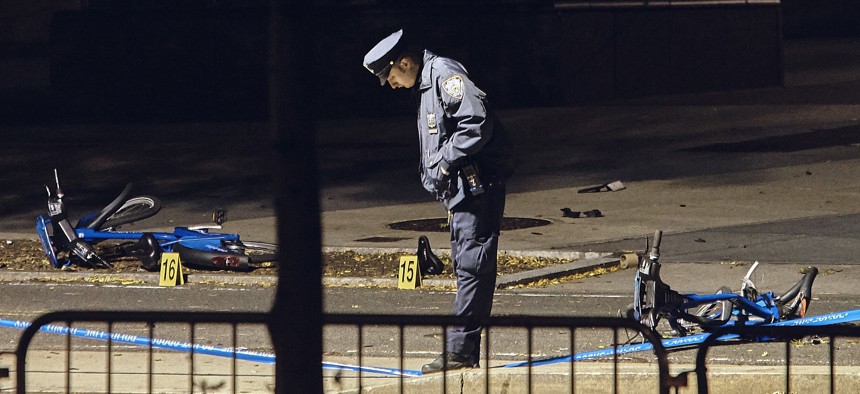
A police officer stands guard next to bicycles on a bike path at the crime scene after a motorist Tuesday drove onto the path, striking and killing several people, in Manhattan, Nov. 1. Andres Kudacki/AP
What the Attack in New York Revealed About the Islamic State's Supporters
As ISIS loses territory, the greatest danger remains that more competent fighters will return home.
Tuesday afternoon, a truck ran down pedestrians, cyclists, and other motorists in Lower Manhattan, killing at least eight. The identity of the alleged attacker, Sayfullo Saipov, has been known for only an hour or two as I write this, but as usual, the details strongly suggest that the man was a complete idiot. He had several models of truck-based terror from which to learn, including that of Mohamed Lahouaiej-Bouhlel, who killed 89 people in Nice on Bastille Day last year. The Islamic State even published a manual that specified the type of truck to rent, and the type of area to attack, for maximum infidel carnage.
Saipov learned nothing from these horrific examples. He emerged from his pickup with what news accounts are describing as a “fake gun,” in one of the most heavily policed areas of Manhattan. The police of the First Precinct “lit him up,” a law-enforcement official told The New York Times, and Saipov is now in custody. As we mourn the dead, we should keep in mind that this attack could have been much worse. It partly resembles Nice, or the Berlin Christmas-market attack. But it also resembles something more pathetic—a suicide by cop.
Media reports indicate that Saipov, a Muslim of Uzbek descent, yelled “Allahu akbar” on the scene, used (however poorly) a signature jihadist tactic, and left a note in the truck declaring his loyalty to isis. All of this strongly suggests New York has witnessed its first fatal terror attack by a follower of the Islamic State. Up to now, according to Seamus Hughes of George Washington University, 143 people have been arrested for Islamic State–related terror offenses in the United States, and about a third of them were planning domestic attacks. (Others were planning journeys to Syria, with the likely intention of fighting there.) So of course one such attack eventually came to fruition and claimed lives. We always knew one would. New York could manage only so many innings of shutout play, and it has held jihadists scoreless since September 11, 2001.
Now come the familiar questions: Could anything have been done? Did he act alone? What, if anything, connects Saipov to the Islamic State’s leadership in Syria? Does the Islamic State’s loss of virtually all its territory in Syria and Iraq mean it will mount even more attacks in the U.S. and Europe?
It doesn’t appear that first responders could have performed better. They neutralized Saipov within minutes. Whether he had assistance or was goaded by Islamic State terror masters in Syria is yet to be known—but I would be surprised to find that he had much help. (What would that help consist of? Renting the wrong kind of truck and driving it down a bike path sounds like a one-man job.)
The last question, about the relationship between this attack and the Islamic State’s losses in Syria, is more perplexing. I harp on Saipov’s apparent stupidity for one reason: As long as the Islamic State’s attackers are idiots like Saipov, our societies can probably handle them. (New York is not freaking out: I see a child dressed as an undead Derek Jeter, fearlessly demanding sugar from strangers on Fifth Avenue, right now.) The Idiots’ Crusade is a manageable problem.
Much less tolerable would be a campaign of competent terror—the kind of mayhem enabled by training, like the 2015 Bataclan killers in Paris had, or by patient planning, as Stephen Paddock in Las Vegas did. There is not much to be done about the idiots, but their idiocy provides a natural limit to the damage they can do. As the Islamic State loses territory, the greatest danger remains the prospect that some of the battle-hardened fighters will return home, raising the average IQ of attackers, and making possible attacks that would be many times more deadly than this one.
America’s strategy in Syria is to demolish the Islamic State, while minimizing the possibility that one of the smart terrorists will slip away. Eight people are dead, tragically, in Lower Manhattan. That the number is not higher is a reminder of how important it is that that strategy be pursued with undiminished vigor.
Related video:



